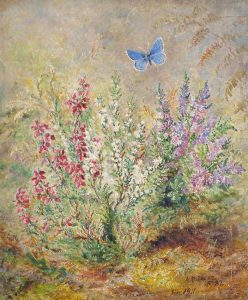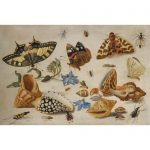The post Adonis Blue Butterflies appeared first on Antique Butterflies.
]]>Adonis Blue Butterflies. The Adonis blue (Lysandra bellargus, also known as Polyommatus bellargus) is a butterfly in the family Lycaenidae. It is found in the Palearctic ecozone (Western Europe, Central Europe, South Europe, South Russia, Iraq, Iran, Caucasus, Transcaucasus, Turkey).
It may be found in chalk downland, in warm sheltered spots, flying low over vegetation, seeking females that are rich chocolate brown in color. The male has brilliantly-colored wings that give it its name.
The Adonis blue is found across Europe from Eastern and Central Europe across to southeast England and the Iberian Peninsula.
The preferred habitat of the Adonis blue is calcareous grasslands with hot and dry conditions. This is because the larva feeds on horseshoe vetch (Hippocrepis comosa) which is largely restricted to these habitats. This plant flourishes on sheep-grazed pastures and disappears after a few years when cattle graze. Sometimes human-created landforms provide refuges for the plant and the butterfly; an example of this is on Martin Down in Dorset, where horseshoe vetch only occurs on ancient earthworks with thin calcareous soils. Reference: Wikipedia


The post Adonis Blue Butterflies appeared first on Antique Butterflies.
]]>The post Swallowtail Butterflies appeared first on Antique Butterflies.
]]>Swallowtail butterflies. Swallowtail butterflies are large, colorful butterflies in the family Papilionidae, and include over 550 species. Though the majority are tropical, members of the family inhabit every continent except Antarctica. The family includes the largest butterflies in the world, the birdwing butterflies of the genus Ornithoptera.
Swallowtails have a number of distinctive features; for example, the papilionid caterpillar bears a repugnatorial organ called the osmeterium on its prothorax. The osmeterium normally remains hidden, but when threatened, the larva turns it outward through a transverse dorsal groove by inflating it with fluid. Reference: Wikipedia







The post Swallowtail Butterflies appeared first on Antique Butterflies.
]]>The post Peacock Butterflies appeared first on Antique Butterflies.
]]>Peacock butterflies. The Peacock Butterfly or Aglais io, is a colourful butterfly, found in Europe and temperate Asia as far east as Japan. It was formerly classified as the only member of the genus Inachis (the name is derived from Greek mythology, meaning Io, the daughter of Inachus). It should not be confused or classified with the “American peacocks” in the genus Anartia; these are not close relatives of the Eurasian species. The peacock butterfly is resident in much of its range, often wintering in buildings or trees. It therefore often appears quite early in spring. The peacock butterfly has figured in research in which the role of eyespots as an anti-predator mechanism has been investigated. The peacock is expanding its range and is not known to be threatened.
The peacock can be found in woods, fields, meadows, pastures, parks, and gardens, from lowlands up to 2,500 metres (8,200 ft) elevation. It is a relatively common butterfly, seen in many European parks and gardens. The peacock male exhibits territorial behaviour, in many cases territories being selected en route of the females to oviposition sites. Reference: Wikipedia








The post Peacock Butterflies appeared first on Antique Butterflies.
]]>